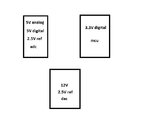seyyah
Advanced Member level 2

I have an ADC in my system and a DAC. How should i design the ground plane, any tips? The board will be 4 layered. I have a 3.3V mcu.
ADC and DAC has a 2.5 reference in common. DAC requires a 12V voltage source. Digital section of the ADC can operate at 3.3V or 5V but i plan to use 5V. Analog voltage supply of the ADC is 5V.
I would appreciate any suggestion on planning the powers and grounds of the pcb, thanks
ADC and DAC has a 2.5 reference in common. DAC requires a 12V voltage source. Digital section of the ADC can operate at 3.3V or 5V but i plan to use 5V. Analog voltage supply of the ADC is 5V.
I would appreciate any suggestion on planning the powers and grounds of the pcb, thanks



